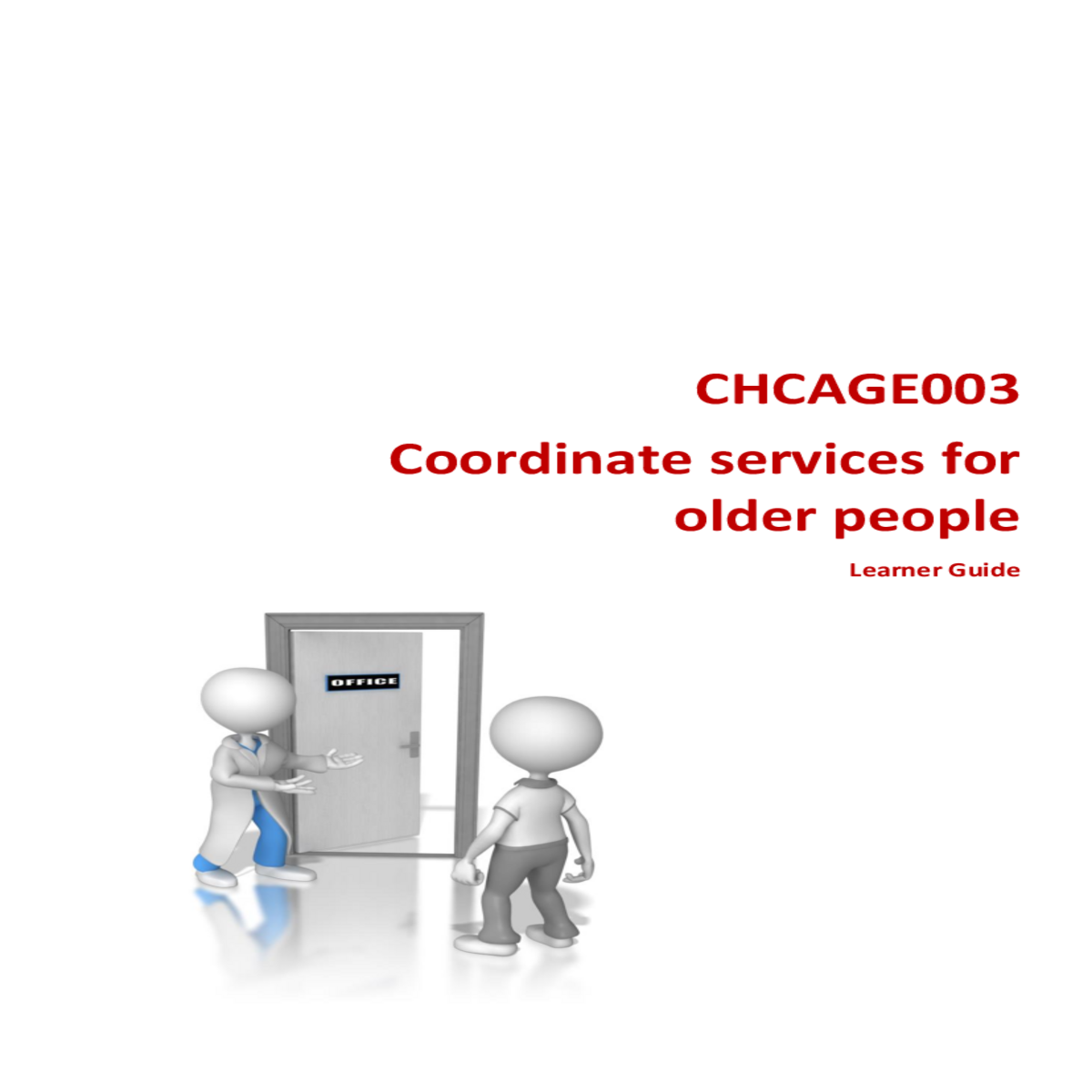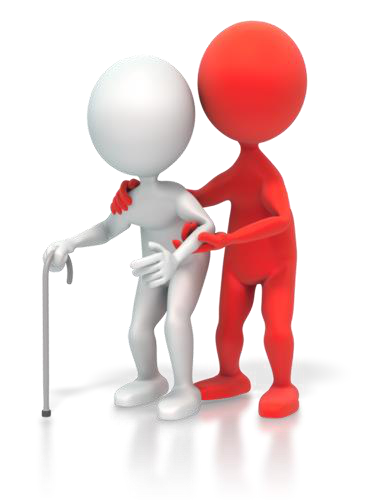Aged care assessment team acat assessments
CHCAGE003
Coordinate services for older people
| Learner Guide |
|---|
Table of Contents
Table of Contents .............................................................................................................................. 2 Unit of Competency ............................................................................................................................. 5 Performance Criteria ............................................................................................................................ 6 Foundation Skills .................................................................................................................................. 7 Assessment Requirements ................................................................................................................... 8 Housekeeping Items ................................................................................................................................ 9 Objectives ................................................................................................................................................ 9 1. Coordinate the delivery of the individualised plan........................................................................ 10 1.1 – Identify and prioritise the needs, goals and preferences of the older person outlined in the individualised plan ................................................................................................................................. 11 Support and assistance for older people ........................................................................................... 11 Creating an individualised plan .......................................................................................................... 12 Negotiation/establishment of goals .................................................................................................. 12 The social model of disability ............................................................................................................. 15 Personalised/cultural communication ............................................................................................... 16 Activity 1A .......................................................................................................................................... 17 1.2 – Coordinate services and support activities in consultation with the older person and colleagues ............................................................................................................................................................... 18 Determining the correct support ....................................................................................................... 18 Assessment for services ..................................................................................................................... 18 Aged care service provider assessments ........................................................................................... 18 Aged care assessment team (ACAT) assessments ............................................................................. 19 Case conferences ............................................................................................................................... 19 Purpose designed tools ...................................................................................................................... 20 Specific problems of the older person ............................................................................................... 21 Activity 1B .......................................................................................................................................... 26 1.3 – Outline and clarify all service providers’ understanding of the individualised plan and their roles and responsibilities ................................................................................................................................ 27 Responsibilities for carrying out care needs ...................................................................................... 27 Case management ............................................................................................................................. 27 Determine all service providers' understanding of the individualised plan ...................................... 28 Activity 1C .......................................................................................................................................... 30

P a g e | 5
The skills in this unit must be applied in accordance with Commonwealth and State/Territory legislation, Australian/New Zealand standards and industry codes of practice.
Unit Mapping Information
Element Performance Criteria
Elements describe the Performance criteria describe the performance needed to essential outcomes. demonstrate achievement of the element.1.Coordinate the 1.1Identify and prioritise the needs, goals and preferences of delivery of the the older person outlined in the individualised plan
individualised plan 1.2Coordinate services and support activities in consultation with the older person and colleagues
1.3Outline and clarify all service providers’ understanding of the individualised plan and their roles and responsibilities 1.4Recognise signs consistent with financial, physical or emotional abuse or neglect of the older person and respond in line with organisation guidelines
P a g e | 7
Foundation Skills
Assessment Requirements
Performance Evidence
The candidate must be able to demonstrate essential knowledge required to effectively complete tasks outlined in elements and performance criteria of this unit, manage tasks and manage contingencies in the context of the work role. This includes knowledge of:
➢The social model of disability
➢Aspects of elder abuse, including:
oindications of neglect or abuse
oemotional impact of abuse
oappropriate management of issues surrounding abuse
➢Manifestations and presentation of common health problems associated with ageing, appropriate actions in response to these problems and when to refer
➢Role and function of various relevant health professionals
➢Relevant community and support services
➢Principles and practices of case management
➢Organisation standards, policies and proceduresOverall, assessment must involve workplace interactions with older people, colleagues, families/carers and working with the older person’s individualised plan.
Assessors must satisfy the Standards for Registered Training Organisations (RTOs) 2015/AQTF mandatory competency requirements for assessors.
Your trainer will inform you of the following:
➢Where the toilets and fire exits are located, what the emergency procedures are and where the breakout and refreshment areas are.➢Any rules, for example asking that all mobile phones are set to silent and of any security issues they need to be aware of.
Objectives
➢Discoverhow to coordinate the delivery of the individualised plan
➢Know how to liaise and negotiate with appropriate personnel and service providers ➢Learnhow to support family and carers
➢Understand how to coordinate feedback
➢Gain skills and knowledge required for this unit
P a g e | 10
1.3. Outline and clarify all service providers’ understanding of the individualised plan and their roles
and responsibilities
1.1 – Identify and prioritise the needs, goals and preferences of the older person outlined in the individualised plan
Support and assistance for older people
Services to assist and support older people can be provided by: ➢Government:
oCommonwealth Government
ostate/territory governments
olocal governments
➢Non-government:
ocommunity services
ovoluntary services
Creating an individualised plan
To provide a person-centred approach to the health and care needs of a person, an individualised plan should be created to establish and carry out the exact care and support needs of an elderly person.
➢Information regarding care arrangements, i.e. if a carer looks after the person, or if other family/friends provide support, such as taking the person out on shopping trips
➢Information about the client’s living arrangements/needs, if employed, their financial support situation, any visitors received and lifestyle factors, such as interests or leisure activities.
As part of a person-centred approach to care, you should collaborate with the older person (in need of care/support), their advocate(s) and/or significant others in creating goals. These goals need to be in the client's interests and meet their legal rights. The goals you set should aim to empower the client and achieve maximum quality of life.
Clients’ interests
Clients’ rights
All clients have specific rights, regardless of whether they are in their own environment or within a residential care home. These are specified in and protected by the Aged Care Act 1997.Clients have the right to:
➢Appropriate care for their needs
➢Access information about their own medical details ➢A choice of suitable treatments
➢Be treated with dignity and respect
➢Live free from abuse and/or neglect
➢Maintain religious practices
➢Use their preferred language
➢Maintain social and personal relationships with others
|
 |
|---|
P a g e | 15
No matter how trivial or insignificant these choices may seem, older people tend to appreciate every one of them and each contributes to their self-worth, autonomy, independence and confidence. Imagine how your quality of life and self-esteem would suffer if you had these kinds of decisions made for you. Time, patience and convenience should not be a factor in implementing clients’ decisions; they should be given time to think about their choices and then their elected choice should be met.
The barriers that exist for people with disabilities include:
➢Physical
Examples of the social model of disability in practical terms are: ➢Adding wheelchair ramps (permanent or temporary) to building entrances
➢Adding elevators to multi-storey buildings
➢Providing funding to allow disabled people to live by themselves independently
➢Having audio description for blind people; visual cues for deaf people.

Communication requirements can vary greatly from one individual to another and from one cultural group to another. This can be more pronounced and significant in the care industry, where clients’ needs and wellbeing is at the forefront of every action; this means that their needs and wants need to be communicated properly, and the service user should also have relevant information communicated to them in a manner which is understandable and friendly.
There can be many different communicative issues encountered by people requiring care, which can range from hearing issues to memory problems. Adjustments should not just be made on the basis of need, but should also meet the clients’ ‘wants,’ in order to show respect and make people as comfortable as possible.
➢Hierarchy
➢Conversational preferences.
P a g e | 18
The types of communication you may have with these personnel include:
➢Liaison
For each type of problem, there is a specific assessment tool to identify and assess the extent of the problems of an older person.
Older people may include:
These are specific assessments provided by the care providers to determine the level of assistance needed for the individual. They will depend on the provider and their specific protocols. Generally, patients will be asked for general health, specific health conditions and their ability to cope with general day-to-day living conditions.
P a g e | 19
The people who are eligible are those with chronic or terminal conditions and complex care needs – they must receive services from their GP and at least two other health/care providers.
Chronic conditions are those which have been present for at least six months and include:
➢Musculoskeletal conditions
➢Cardiovascular disease.
|
 |
|---|








